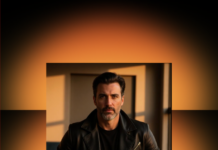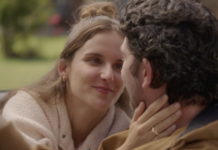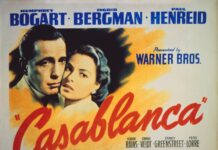Good movies and good books share similarities. No matter how many times you have read one, a great book will draw you back time and again just like a good movie.

Right now, the world is a lot more obsessed with series but the magic of old and classic movies has not faded yet. This blog will delve into the top four classics that are still shining bright in the galaxy.
- The Lord of the Rings: The Fellowship of the Ring (2001)
When The Lord of the Rings: The Fellowship of the Ring hit theaters in 2001, it did more than bring J.R.R. Tolkien’s beloved fantasy world to life — it redefined the fantasy genre in cinema. Directed by Peter Jackson, the film marked the beginning of an epic journey that captivated audiences and critics alike. But what makes The Fellowship of the Ring one of the greatest movies ever made? Let’s dive into the reasons that solidify its place in cinematic history.
A Faithful Yet Innovative Adaptation
Adapting a book as intricate and revered as The Lord of the Rings was no small feat. Peter Jackson and his team had the monumental task of transforming Tolkien’s richly detailed world into a visual spectacle while staying true to the source material.
While some changes were made to streamline the narrative for the film, the heart and soul of Tolkien’s story remained intact. Jackson captured the spirit of the Shire, the grandeur of Rivendell, and the perilous journey through Moria with a level of detail that resonated with lifelong fans and newcomers alike. The film’s ability to translate such a complex narrative into a coherent and emotionally compelling experience is a testament to its brilliance.
Stunning Visuals and Groundbreaking Effects
Even over two decades later, The Fellowship of the Ring remains visually stunning. Weta Workshop and Weta Digital, the visual effects powerhouses behind the film, pushed the boundaries of what was possible at the time. From the sweeping landscapes of New Zealand standing in for Middle-earth to the terrifying realism of the Balrog in Moria, the film’s visual effects blend practical and digital elements seamlessly.
The use of forced perspective to depict the size difference between Hobbits and other characters was a stroke of genius that added authenticity to the fantasy world. Jackson’s choice to film on location in New Zealand also gave the movie a grounded, earthy feel that CGI-heavy films often lack.
An Unforgettable Cast and Performances
The success of The Fellowship of the Ring hinges on the strength of its ensemble cast, and Jackson assembled a near-perfect group of actors.
- Elijah Wood embodied the innocence and quiet courage of Frodo Baggins, making audiences emotionally invested in his perilous journey.
- Ian McKellen delivered a career-defining performance as Gandalf the Grey, exuding wisdom, warmth, and strength.
- Viggo Mortensen as Aragorn brought both nobility and vulnerability to a character struggling with his destiny.
- Sean Bean’s portrayal of Boromir added complexity and emotional weight, culminating in a tragic and memorable redemption.
The chemistry between the cast made the bonds of the Fellowship feel genuine, drawing viewers deeper into the narrative.
Cultural Impact and Lasting Legacy
The Fellowship of the Ring didn’t just capture the hearts of audiences — it left an indelible mark on cinema. It revitalized the fantasy genre, paving the way for other ambitious projects to follow. The film earned critical acclaim, multiple Academy Award nominations, and widespread commercial success, solidifying its place as a cultural phenomenon.
Moreover, it introduced a new generation to Tolkien’s work, ensuring that Middle-earth would continue to inspire and captivate fans for decades to come.
- Star Wars: The Empire Strikes Back (1980)
When Star Wars: A New Hope (1977) took the world by storm, it was clear that George Lucas had created something special. But it was the sequel, The Empire Strikes Back, released in 1980, that cemented Star Wars as a cinematic phenomenon. Directed by Irvin Kershner and written by Leigh Brackett and Lawrence Kasdan, The Empire Strikes Back took everything great about the original and elevated it to new heights. More than 40 years later, it remains not only one of the greatest sequels of all time but also one of the greatest movies ever made. Here’s why.
A Sequel That Dared to Be Darker and Deeper
While A New Hope was a thrilling space adventure with a feel-good ending, The Empire Strikes Back took a bold narrative risk by diving into darker, more complex territory. It explored the emotional struggles of its characters, deepened the mythology of the galaxy, and left audiences reeling with a cliffhanger that would become legendary.
The film embraced uncertainty and failure — a rarity in blockbuster cinema at the time. Our heroes don’t win. Luke Skywalker faces a devastating loss, Han Solo is frozen in carbonite, and the Rebellion is left in a precarious position. This willingness to subvert expectations gave The Empire Strikes Back a gravitas that few sequels achieve.
Iconic Plot Twists That Redefined Storytelling
No discussion of The Empire Strikes Back is complete without mentioning one of the greatest plot twists in cinematic history: “I am your father.”
Darth Vader’s revelation to Luke Skywalker shattered audience assumptions and added layers of complexity to the saga. It transformed Vader from a one-dimensional villain into a tragic figure and reframed Luke’s journey as not just a fight between good and evil, but a deeply personal struggle with his own lineage and destiny.
This twist elevated the stakes and set the stage for Luke’s emotional and moral conflict in Return of the Jedi, giving the trilogy an emotional core that resonated with audiences for generations.
Character Development at Its Finest
The Empire Strikes Back allowed its characters to grow in meaningful and often painful ways.
- Luke Skywalker evolves from an eager farm boy into a Jedi-in-training, grappling with self-doubt and the burden of his destiny. His time on Dagobah with Yoda is not just about learning the Force but about confronting his own fears and limitations.
- Han Solo transitions from a self-serving smuggler to someone capable of deep love and sacrifice. His relationship with Leia adds emotional weight to his eventual capture and carbonite imprisonment.
- Princess Leia shows her strength not just as a leader of the Rebellion but as someone capable of vulnerability, particularly in her relationship with Han.
- Darth Vader transforms from a menacing villain to a conflicted, tragic figure, hinting at the redemption arc that would follow.
This emotional depth made the characters more relatable and their journeys more compelling.
- The Godfather (1972)
Few films in history have had the lasting impact of The Godfather. Released in 1972 and directed by Francis Ford Coppola, this cinematic masterpiece is not just one of the best gangster films ever made—it’s one of the greatest movies of all time, period. With its impeccable storytelling, unforgettable performances, and deep thematic richness, The Godfather has stood the test of time as a cultural and artistic landmark. But what makes it so exceptional? Let’s break it down.
A Perfectly Crafted Story
At its core, The Godfather is a story about family, power, and the American Dream. Based on Mario Puzo’s novel, the film follows the Corleone crime family as they navigate loyalty, betrayal, and the brutal world of organized crime.
Unlike typical gangster films that glorify violence, The Godfather presents a nuanced look at the cost of power. It’s not just about mob hits and backroom deals—it’s about the choices that define a man’s legacy. The story’s depth, combined with Coppola’s masterful pacing, keeps audiences engaged from the first frame to the last.
Unforgettable Characters and Performances
One of the most remarkable aspects of The Godfather is its legendary cast, each delivering performances that have become the stuff of Hollywood history.
- Marlon Brando as Vito Corleone: Brando’s portrayal of the aging mafia don is one of the most iconic performances in film history. His quiet authority, combined with his deep sense of family loyalty, makes Vito Corleone more than just a ruthless crime boss—he’s a deeply human character.
- Al Pacino as Michael Corleone: The film is, in many ways, Michael’s story. Pacino’s transformation from a reluctant outsider to a cold-blooded mafia leader is nothing short of masterful. His evolution is slow, subtle, and chilling.
- James Caan as Sonny Corleone: The hotheaded eldest Corleone son is the opposite of Michael—impulsive and emotional. Caan’s performance adds energy and tension, making Sonny’s fate all the more tragic.
- Robert Duvall as Tom Hagen: As the family’s consigliere, Duvall brings a sense of calm intelligence to the role, showing the Corleones’ business side with quiet confidence.
Every character in The Godfather feels real and fully developed, making their triumphs and downfalls deeply compelling.
Cinematography and Direction That Defined a Genre
Francis Ford Coppola’s direction is nothing short of visionary. The film’s cinematography, led by Gordon Willis, is legendary for its moody lighting, careful framing, and striking use of shadows. The dimly lit interiors and warm, golden hues create a sense of intimacy while also emphasizing the film’s dark themes.
Coppola’s attention to detail is impeccable. From the opening wedding sequence to the haunting final scene, every shot is meticulously crafted. The film is slow-paced compared to modern crime dramas, but every scene is purposeful, building tension and depth in ways that few movies ever achieve.
- The Dark Knight (2008)
When The Dark Knight hit theaters in 2008, it didn’t just redefine the superhero genre — it elevated it to a level of cinematic excellence rarely seen in blockbuster films. Directed by Christopher Nolan and anchored by a phenomenal cast, The Dark Knight wasn’t just a comic book movie. It was a gritty crime thriller, a moral dilemma, and a meditation on chaos and justice. Over 15 years later, it remains a benchmark of modern cinema and is widely regarded as one of the greatest films of all time. Here’s why.
A Superhero Movie That Transcended Its Genre
Before The Dark Knight, superhero movies were largely seen as entertaining but formulaic. While Batman Begins (2005) laid the groundwork with a darker and more grounded origin story, The Dark Knight took things to another level. It wasn’t just a superhero movie — it was a tense, morally complex crime thriller that drew comparisons to classics like Heat and The Godfather.
Nolan crafted a film that explored the thin line between hero and villain, good and evil, and the cost of maintaining order in a chaotic world. Audiences weren’t just watching Batman stop a villain — they were witnessing a philosophical battle that questioned the very nature of justice.
Heath Ledger’s Iconic Joker: A Performance for the Ages
One of the biggest reasons The Dark Knight stands out is Heath Ledger’s unforgettable portrayal of the Joker. Ledger’s Joker was unlike any other villain seen on screen. He wasn’t driven by money or power — he was an agent of chaos, someone who simply wanted to watch the world burn.
Ledger’s performance was mesmerizing, unsettling, and utterly transformative. He disappeared into the role, crafting a Joker who was unpredictable, terrifying, and darkly charismatic. His mannerisms, the chilling laugh, and the iconic line ‘Why so serious?’ became instantly iconic. Ledger’s untimely death before the film’s release added a layer of poignancy to his performance, which earned him a posthumous Academy Award for Best Supporting Actor.
A Morally Complex Hero in Batman
Christian Bale’s portrayal of Bruce Wayne/Batman in The Dark Knight was not just about gadgets and fighting crime. This Batman grappled with real moral dilemmas, making impossible choices and sacrificing his personal happiness for the greater good.
- Bruce Wayne’s internal conflict is at the heart of the film. He wants to leave behind the cape and cowl, believing that Harvey Dent can be the true hero Gotham needs. But as the Joker unleashes chaos, Bruce realizes that the line between good and evil isn’t always clear.
- The cost of being Batman becomes painfully evident as Bruce loses Rachel Dawes and watches Gotham’s hope, Harvey Dent, fall from grace. Batman ultimately takes the blame for Dent’s crimes to preserve Gotham’s faith in its system — a sacrifice that leaves him a hunted vigilante.
Bale’s performance brought depth and vulnerability to a character often portrayed as invincible, making audiences emotionally invested in his journey.
A Timeless Classic That Stands the Test of Time
Even after multiple viewings, The Dark Knight retains its intensity, emotional weight, and relevance. Its exploration of chaos, morality, and sacrifice continues to resonate with audiences, ensuring its place as a cinematic masterpiece.
















